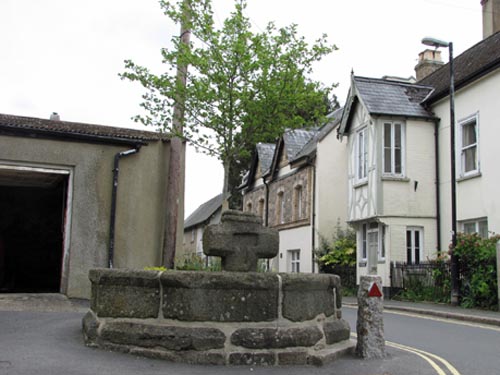
 |
 Location:
In Cross Street,
Moretonhampstead, near the South entrance to the church. Location:
In Cross Street,
Moretonhampstead, near the South entrance to the church.O/S Grid Ref: SX/75507/86044 Longitude/Latitude (Degrees+/-): -3.76272/50.66072 Map location: Click here to view map. Purpose: Village Cross. Size: 1 foot 11 inches (0.58 metres) tall. 2 feet 3 inches (0.69 metres) across the arms. Information: The cross is situated in a large octagonal pedestal, with the width of each side of the pedestal varying between three and four feet and about 2 feet 6 inches in height. There have, to our knowledge, been three trees planted within the pedestal to accompany the cross. The original tree was an elm, known as ‘The Dancing Tree’. It got this name from the fact that it was pollarded in such a way that a platform could be built on top of the trunk, which was used by the villagers for dancing and other entertainment. There were railings around the outside of the platform and it was reached by a flight of steps leading up from a nearby garden.
Only the head and a short length
of the original shaft of the cross now remain in position. The outside
face of the cross has an incised shape of a capital ‘T’, with a
rectangular recess being incised on the inner
He later became the chief engineer on the Norwich & Lowestoft line and, in the course of this project, became the first person to design a swing bridge for a railway line. However, his most important work was the survey and plans he drew up for the Victoria Docks in London. Other notable achievements were the publishing of the ‘Bidder Tables’ to calculate the volume of earth to be moved for an embankment or cutting, he was a co-founder of the Electric Telegraph Company and, together with Stephenson, visited Switzerland to assist with the plans for the Swiss Federal Railway System. In later years he retired to the Dartmouth area, where he was a founder of the Dart Yacht Club and was responsible for acquiring its Royal Warrant. He died in 1878 and is buried in the churchyard at Stoke Fleming. He was survived by his wife, Georgina, together with their eight children and twenty-eight grandchildren. |